Pineapples
So today’s post is inspired by the harvesting of our first pineapple. We managed to beat the possums to it and we simply halved it lengthways and ate it with a spoon. Deliciously sweet and juicy. It got me thinking though about my pineapple history and so here goes.
Pineapples were an exotic fruit when I was growing up in Canberra. Our regular forays to the Fyshwick markets never produced a pineapple. Those visits always had Dad driving us to the markets but he sat in the car, he never got out. Our first port of call was to get him a bag of boiled peanuts which he would eat while we purchased. Anyway I was introduced to pineapple on our family holidays to Queensland. Queensland is where pineapples are grown in Australia. Commercial production began in the 1840s and is now centred on Nambour on the Sunshine Coast, Mareeba and Yeppoon in far North Queensland. Production used to be far more widespread with plantations in Nundah, Nudgee and Sunnybank - now completely suburbanised.
We would always visit the Big Pineapple and the Big Cow. The Big Pineapple was a large fibreglass fruit which you could actually go inside. Then it would be a quick look at the plantation before heading to the cafeteria. Well it was a tropical fruit paradise mango, passionfruit, macadamias and of course pineapple. The sundaes came in hollowed out half pineapples - piled high with fruit salad, cream and ice cream. They were just divine. On the way out was through a cornucopia of tourist bits and bobs. Postcards, tea towels, pencils, erasers, rulers, back scratchers and of course teaspoons.
During my dietetic degree we had to prepare a three minute presentation to teach a new skill. My presentation was on how to tell if a pineapple is ripe. So the three top tips are:
Colour - Pineapples don’t ripen once they are picked and so they need to have some yellow on them. They ripen from the bottom up. So the bottom may be golden but the top a little greenish.
Smell - Always smell a pineapple. Smell its base - it should smell fruity and sweet
Feel - It should be firm to the touch, that is, not squishy, but also not rock hard. You should be able to pull out a frond from the crown fairly easily.
Queensland Archives ITM1514355
Pineapples really were a Queensland industry. In the 1940s Golden Circle was a cooperative of growers that canned the fruit and the juice. Tinned pineapple juice made its may into a lot of tropical punches. Sadly Golden Circle were bought out by Heinz in 2008 who then merged with Kraft in 2015. So what was once a local endeavour is now in the hands of a multinational. They are however still providing jobs to Australians but I always check the label to make sure that firstly what is inside is Australian grown and secondly that it was canned, packaged in Australia as well.
So what are the recipes that I am going to share with you. Well the first one is PINEAPPLE FRUIT MELANGE from the NSW Country Women’s Association Cookbook and the second is one of my favourite salsas that I serve with salmon.
Pineapple Salsa (Serves lots)
Ingredients
1 small, fresh pineapple, skinned, cored and cut into chunks
1 small chilli, finely chopped
1/2 small red onion, finely chopped
Fish sauce to taste (just a couple of splashes)
1/2 bunch finely chopped coriander. Coriander gives it a lovely flavour but if you have family members like I do who have the coriander yuck gene then mint works well too.
Method
Combine. Serve with fish. We usually have it as a side to a poke bowl or to lightly steamed salmon






